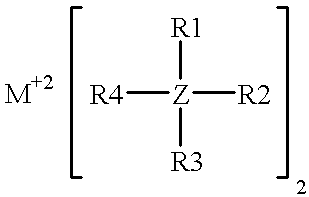High-energy, rechargeable, electrochemical cells with non-aqueous electrolytes
- Summary
- Abstract
- Description
- Claims
- Application Information
AI Technical Summary
Problems solved by technology
Method used
Image
Examples
example 2
Referring now to the drawings, FIG. 1a and FIG. 1b are graphs displaying typical cyclic voltammograms of ether-magnesium organo- halo-aluminates solutions in tetrahydrofuran (THF) using a gold electrode.
FIG. 1a shows the potentiodynamic behavior of Mg(AlCl.sub.3 Bu).sub.2 obtained with THF solution using a gold working electrode. The peak at -1 V is due to the deposition of magnesium metal, and the peak at around 0.9 V is attributed to the subsequent electrochemical dissolution of the magnesium metal. The electrochemical window obtained with this system exceeds 2.6 V. It is clearly evident from the cyclic voltammogram that the process of magnesium deposition and dissolution is fully reversible.
The potentiodynamic response of Mg(AlCl.sub.2 BuEt).sub.2 in THF solution is given in FIG. 1b. The electrochemical window spans over 2.3 V, with a magnesium deposition peak starting at -0.3 V (vs.Mg / Mg.sup.+) with subsequent magnesium redissolution peak occurring at 0.4 V. As in the previous c...
example 3
An electrochemical cell was prepared consisting of a Chevrel-phase cathode, a magnesium metal anode, and an electrolyte containing Mg(AlCl.sub.2 BuEt).sub.2 salt in THF. The 25.7 mg cathode was made from a mixture of copper-leached Chevrel-phase material containing 10 weight-% carbon black and 10 weight-% PVDF as a binder, spread on stainless steel mesh. The solution was prepared from 0.25 Molar Mg(AlCl2BuEt)2 salt in THF. The anode was a disc of pure magnesium metal, with a diameter of 16 mm and a thickness of 0.2 mm. The battery was encased in a stainless steel "coin cell" configuration with a paper separator made from glass fibers. The cell was cycled on a standard charger-discharger with a current density of 23.3 milliamperes / gram. The potential limits for the cycling were between 0.5 V at the fully discharged state and 1.8 V for the fully charged state.
The battery was subjected to continuous cycling over 3 months. The excellent cyclability of the battery is clearly evident from...
example 4
An electrolyte according to the present invention was prepared as follows: commercial, reagent-grade MgBu.sub.2, was dissolved in heptane. Commercial, reagent-grade AlEtCl.sub.2 was added drop wise to the MgBu.sub.2 solution according to the molar ratio. The mixture was stirred for 48 hours under an inert gas, and Mg(Bu.sub.2 AlCl.sub.2).sub.3 was crystallized out of solution. The solvent was removed by evacuation. Ether solvents were added very slowly to the organomagnesium salt to produce a saturated solution (around 0.5M).
The ionic conductivity of the saturated Mg(Bu.sub.2 AlCl.sub.2).sub.3 solution was 6.9.sup.* 10.sup.-3 Scm.sup.-1 mol.sup.-1 at 100 kHz in a parallel cell configuration.
PUM
 Login to View More
Login to View More Abstract
Description
Claims
Application Information
 Login to View More
Login to View More - R&D
- Intellectual Property
- Life Sciences
- Materials
- Tech Scout
- Unparalleled Data Quality
- Higher Quality Content
- 60% Fewer Hallucinations
Browse by: Latest US Patents, China's latest patents, Technical Efficacy Thesaurus, Application Domain, Technology Topic, Popular Technical Reports.
© 2025 PatSnap. All rights reserved.Legal|Privacy policy|Modern Slavery Act Transparency Statement|Sitemap|About US| Contact US: help@patsnap.com



